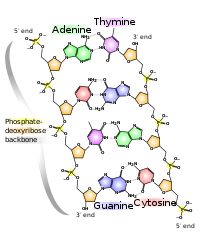
Photo from wikipedia
Self-assembled virus-like particles (VLPs) hold great potential as natural nanomaterials for applications in many fields. For such purposes, monodisperse size distribution is a desirable property. However, the VLPs of simian… Click to show full abstract
Self-assembled virus-like particles (VLPs) hold great potential as natural nanomaterials for applications in many fields. For such purposes, monodisperse size distribution is a desirable property. However, the VLPs of simian virus 40 (SV40), a representative VLP platform, are characterized by polymorphism. In an attempt to eliminate the polymorphism, 15 mutants of the VLP subunit (VP1) are constructed through the substitution of double cysteines at the VP1 pentamer interfaces, generating a group of VLPs with altered size distributions. One of the mutants, SS2 (L102C/P300C), specifically forms homogenous T = 1-like tiny VLPs of 24 ± 3 nm in diameter. Moreover, the stability of the SS2 VLPs is markedly enhanced compared with that of wild-type VLPs. The homogeneous self-assembly and stability enhancement of SS2 VLPs can be attributed to the new disulfide bonds contributed by Cys102 and Cys300, which are identified by mass spectrometry and explored by molecular dynamics simulations. Endocytosis inhibition assays indicate that SS2 VLPs, like the polymorphic wild-type VLPs, preserve the multipathway feature of cellular uptake. SS2 VLPs may serve as an evolved version of SV40 VLPs in future studies and applications. The findings of this work would be useful for the design and fabrication of VLP-based materials and devices.
Journal Title: Small
Year Published: 2020
Link to full text (if available)
Share on Social Media: Sign Up to like & get
recommendations!